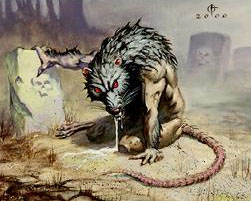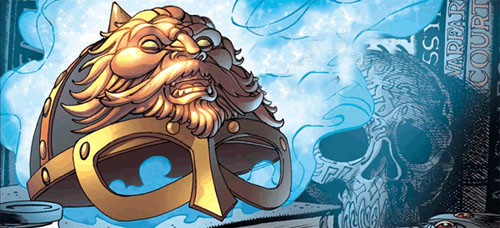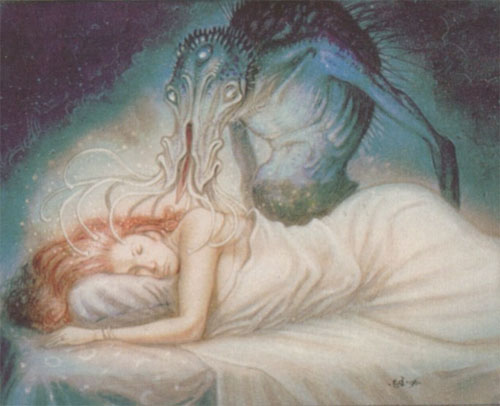
This is more of a mini-reaction, but during last night’s session I was suddenly struck by something in OD&D’s description of vampires:
VAMPIRES: These monsters are more properly of the “Undead” class rather than Lycanthropes.
Whenever I read that passage, I would think to myself, “Well… yeah.”
But tonight I had an epiphany which may already be obvious to some of you: “Oh! Of course! They could be classified as lycanthropes because they turn into wolves.” (This may be because I’ve been spending a bit more time than usual around Dracula.)
Bit of a digression here: I went to see Blade II in the theater with a large group of friends and friends-of-friends. My most vivid memory of the experience comes from the car ride home, when I listened to someone in the backseat ramble on for 15 minutes about all of the different ways in which Blade II had violated the continuity of Vampire: The Masquerade.
Now, I’ll be the first to admit that Blade II took it’s fair share of inspiration from the milieu of the World of Darkness. But it is also self-evidently not the same setting and, therefore, not bound by its rules.
With that being said, I do think it’s interesting to note the degree to which roleplaying games encourage us to think about myth and fiction in terms of categories and quantifications.
To explain what I mean, let me digress again: We interpret all media through the lens of our previous experiences with media, a fact that I think can probably be seen most clearly when we are young (and our exposure to media limited). For example, I can remember when any new work of space opera I encountered was first understood in the context of Asimov’s Foundation Trilogy and Star Trek. Unless the author clearly established a delineation, I just sort of assumed that their universe worked like an admixture of the Federation and the Galactic Empire. This wasn’t a conscious choice on my part: It was just that my formative experiences with these works had created a lens through which other experiences were understood.
This is an effect which has been significantly diffused as my exposure to science fiction has broadened and deepened, but this doesn’t mean it’s gone away: When an author invokes the Singularity, my brain promptly plops in a whole gestalt understanding of what that means based on exposure to Vinge and Stross and MacLeod and Transhuman Space and Eclipse Phase and God only knows what else. Because it’s diffused, I think it’s easier for each work to make its unique impression upon me. But that filter of previous experience can’t be fully escaped.
So, to escape out of this recursive sequence of digressions, let me say this: Sitting in that car 10+ years ago, I could shake my head sadly at someone who interpreted all fiction through the lens of a roleplaying game. But it took this sudden epiphany regarding OD&D vampires to realize the degree to which a youth spent pouring over Monster Manuals had planted some pretty deeply rooted hierarchies into my understanding of the fantastic.
Vampires are undead.
So are skeletons and zombies. Actually, the clear-cut and categorical distinction between skeletons, zombies, and ghouls (among other things) is something else that I almost certainly owe to D&D.
And this isn’t just me. And it isn’t just limited to roleplaying games. By vector of fantasy fiction and film and computer, this stuff has seeped into the cultural gestalt.
This was something we talked about during rehearsals of Drakul: I think it’s actually impossible for any person in the modern world to fully appreciate Bram Stoker’s Dracula.
I mean, I’m generally somebody who really enjoys reading works with an eye towards their historical context: I get a huge kick out of reading Skylark in Space and realizing that this shit had never been done before. I can feel the vicarious thrill of imagining what it would be like to read that book for the first time in 1928. But with Dracula I can’t quite pull it off: I mean, I can sort of intellectually see that Stoker is very carefully hiding the true nature of Dracula from his readers and treating it as a terrific mystery. I can logically conclude that Victorian readers would be wondering what strange and horrible curse had afflicted Lucy.
But my brain just keeps thinking, “It’s a vampire.” She has bite marks on her neck? It’s a vampire. She’s experiencing acute blood loss? It’s a vampire. C’mon, let’s get with the program. It’s a vampire.
And so forth.
To make a long story short: I find the degree to which pop culture fantasy has eradicated the mystery of the mythic interesting to consider. Perhaps even more interesting is the question of how we can inject that sense of mystery (and majesty) back into our own fantasies.
Back to Reactions to OD&D
 In “Tales from the Table: Gems in the Belly” yesterday, I mentioned the use of wererat ghouls in my restocking of Atarin’s Delve. Here’s what those look like (using a mixture of an AD&D stat block with OD&D verbiage):
In “Tales from the Table: Gems in the Belly” yesterday, I mentioned the use of wererat ghouls in my restocking of Atarin’s Delve. Here’s what those look like (using a mixture of an AD&D stat block with OD&D verbiage):













